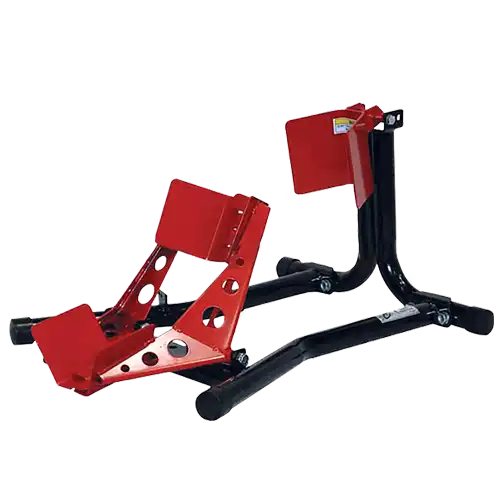Understanding Motorcycle Wheel Chocks and Wheel Stands
Defining Motorcycle Wheel Chocks
A motorcycle wheel chock is a device designed to secure the front wheel of a motorcycle, preventing it from moving or rolling. It's typically used during transportation or storage to keep the bike upright and stable. Wheel chocks come in various designs, from simple V-shaped cradles to more complex locking mechanisms. The primary function of a wheel chock is to provide a secure anchor point for the front wheel, ensuring the motorcycle remains stationary.
Exploring Wheel Stands
Wheel stands, also known as paddock stands or motorcycle lifts, are tools used to elevate either the front or rear wheel of a motorcycle off the ground. They're essential for maintenance tasks, allowing easy access to the wheels, chain, and other components. Wheel stands come in different types, including front stands, rear stands, and combination stands that can lift both wheels simultaneously. These stands provide stability and support while working on the bike, making them invaluable for both professional mechanics and DIY enthusiasts.
Key Differences and Similarities
While both motorcycle wheel chocks and wheel stands aim to stabilize motorcycles, their purposes and applications differ significantly. Wheel chocks are primarily used for securing bikes during transport or storage, offering a compact solution for keeping the motorcycle upright. In contrast, wheel stands are designed for maintenance and repair work, providing elevation and access to various parts of the bike. Despite these differences, both tools share the common goal of ensuring motorcycle stability and safety. Understanding these distinctions is crucial for riders to make informed decisions about which tool best suits their needs.
Advantages and Disadvantages of Motorcycle Wheel Chocks
Benefits of Using Wheel Chocks
Motorcycle wheel chocks offer several advantages that make them a popular choice among riders. Firstly, they provide exceptional stability during transportation, preventing the bike from shifting or falling over in a trailer or truck bed. This security is particularly valuable when moving motorcycles over long distances or on bumpy roads. Additionally, wheel chocks are compact and portable, making them easy to store and transport. They're also versatile, often compatible with various motorcycle models and sizes. For those who frequently transport their bikes or need a reliable storage solution, wheel chocks offer peace of mind and convenience.
Limitations of Wheel Chocks
Despite their benefits, motorcycle wheel chocks do have some limitations. One of the primary drawbacks is their limited functionality beyond securing the front wheel. Unlike wheel stands, chocks don't provide elevation or access to the underside of the motorcycle, which can be a significant disadvantage for maintenance tasks. Furthermore, some riders find that certain wheel chock designs can be challenging to use, especially when maneuvering heavy motorcycles into position. There's also the consideration that not all wheel chocks are created equal - cheaper models may lack the durability and security features of higher-end options, potentially compromising the safety of your bike.
Scenarios Where Wheel Chocks Excel
Wheel chocks truly shine in specific scenarios. They're indispensable for motorcycle transport, whether you're hauling your bike in a trailer, pickup truck, or moving van. In these situations, a well-designed wheel chock can prevent costly damage from tip-overs or shifting during transit. Wheel chocks are also excellent for long-term storage, particularly in garages or storage units where space might be limited. They allow bikes to be stored upright, taking up less floor space while remaining stable. For motorcycle dealers or collectors with multiple bikes, wheel chocks offer an efficient way to organize and secure a fleet of motorcycles in a compact area.
Pros and Cons of Wheel Stands
Advantages of Wheel Stands
Wheel stands, often used with a motorcycle wheel clamp, offer numerous benefits that make them essential tools for motorcycle maintenance and repair. One of the primary advantages is the ability to elevate the motorcycle, providing unobstructed access to the wheels, undercarriage, and other components. This elevation is crucial for tasks such as chain maintenance, oil changes, and tire replacements. Wheel stands also distribute the weight of the motorcycle evenly, reducing stress on the suspension and tires during prolonged periods of storage or work. Additionally, they enhance safety during maintenance by providing a stable platform, reducing the risk of the bike tipping over while you're working on it.
Drawbacks of Wheel Stands
While wheel stands are invaluable for maintenance, they do have some limitations. One notable drawback is their size and portability - wheel stands are generally bulkier and heavier than wheel chocks, making them less convenient for transport or storage in limited spaces. They also require more setup time compared to the quick deployment of a wheel chock. Another consideration is that wheel stands typically require more strength and skill to use effectively, especially when lifting heavier motorcycles. There's also the potential for damage if the stand is not properly positioned or if the bike is not securely mounted, which underscores the importance of using wheel stands correctly.
Ideal Use Cases for Wheel Stands
Wheel stands are indispensable in various scenarios, particularly in maintenance and repair settings. They're essential for professional motorcycle workshops, where technicians need constant access to different parts of the bike. For home mechanics, wheel stands facilitate a wide range of DIY tasks, from basic oil changes to more complex repairs. They're also valuable for motorcycle enthusiasts who enjoy customizing their bikes, allowing for easy installation of aftermarket parts. In racing environments, wheel stands are crucial for quick tire changes and last-minute adjustments. For long-term storage, especially in climates with extreme temperatures, using a wheel stand can help preserve tire shape and prevent flat spots by keeping the wheels off the ground.
Conclusion
In the debate between motorcycle wheel chocks and wheel stands, there's no definitive winner - each tool serves distinct purposes and excels in different scenarios. Wheel chocks offer unparalleled security during transport and storage, while wheel stands are indispensable for maintenance and repairs. The best choice ultimately depends on your specific needs as a rider. For comprehensive motorcycle care, having both tools at your disposal provides the most versatility. Remember, investing in quality equipment, whether it's a robust wheel chock or a reliable wheel stand, is crucial for ensuring the safety and longevity of your beloved motorcycle.
Contact Us
Ready to enhance your motorcycle maintenance and storage solutions? Contact RUNVA ENTERPRISES LIMITED for expert advice and high-quality motorcycle accessories. Reach out to us at info@runva.com.cn to explore our range of professional-grade wheel chocks, stands, and other essential tools designed to keep your motorcycle secure and well-maintained.

_1737625693698.webp)


